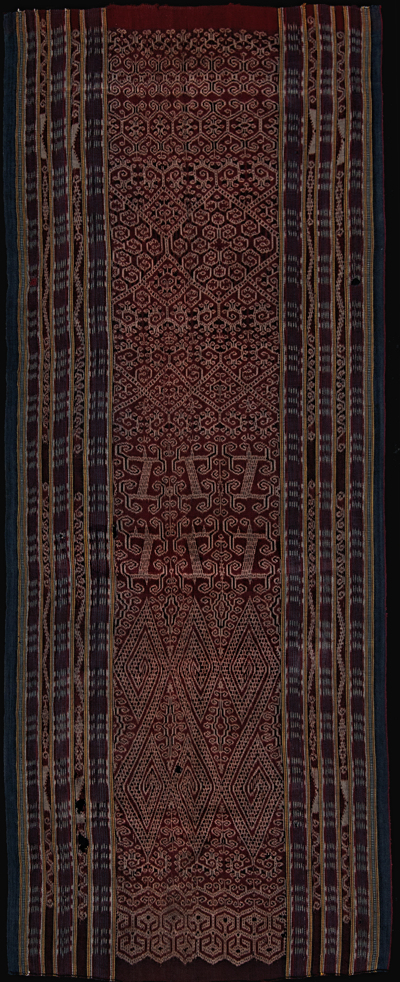| |
 
 | | | |
300 Borneo, Kalimantan
Kain kebat (skirt)  
| | Locale: | Ketungau river region | | Period: | 19th c. | | Yarn: | Cotton, hand-spun, extremely fine | | Technique: | Warp ikat | | Panels: | 1 | | Size: | 51.5 x 130 cm (1' 8" x 4' 3") LW: 2.52 | | Weight: | 80 g (2.8 oz), 119 g/m2 (0.39 oz/ft2) | | Design: | Tripartite field division, with different designs per section - a hallmark of Ketungau kain kebat. Another Ketungau hallmark is a band of linked hexagons, single or double. The motif in the top third is leku Nengali, the snake Nengali's tail, one of the Dayaks' most popular motifs. The design relies on a triple repeat of the basic ikated motif, in a LR-RL-LR arrangement that gives the piece great inner tension. The weaver shows off her consummate skills by very complex drawing, with some elements (the lozenges just above the middle) shown half once, twice full, then half again; the larger lozenges in the top section once full, then half; above them three identical motifs; above those first one half lozenge, then five full, then one more half. This is an astonishingly complex design to imagine, leave alone to tie onto a warp folded over into three separate warp beds. Few other Dayaks reach this level of sophistication. Perhaps only the Saribas are competitive enough to create such intentional complexity. Mind you, weaving a kain kekat was seen as a diversion in between the serious work of weaving pua. | | Comment: | Antique kain kebat from the Ketungau - the most intricate we encountered so far - made of extremely fine hand-spun. Note the weight of merely 80g and specific weight of 119 g/m2, just twice that of gossamer Buginese silks. The yarn shows the wildly irregular gauge that we have come to associate with 19th c. and older. While the colours are still strong, giving the drawing good contrast, the skirt's age is betrayed by ten small holes, luckily mostly in the borders. Three dotted longitudinal border stripes, decorated with groups of three whitish blocks, yet another Ketungau hallmark, not as easily recognized here as on PC 242, more similar to the treatment on PC 212. | | Background: | Chapters on Borneo and Kalimantan. | | Compare: | 212 220 229 242 243 | | Sources: | Very similar to undated but old-looking kain kebat identified as Desa in Heppell, The Seductive Warp Thread, p. [check]. Comparable, in terms of field division and hallmarks, to the Ketungau kain kebat in the Amann collection, Khan Majlis, Textiles from Borneo, Plates 88-90, though of another level of intricacy. Kreifeldt pers. comm. 2018: 'The curled motifs at the bottom are called sandong - very typical of Ketungau as are the borders. The sandong might almost be called a diagnostic of traditional Ketungau skirts as it does not seem to occur on skirts of any others; except that now modern Desa are using it. Commonly it occurs on the �dark� end of the skirt. Sandong is a bone ossuary and on skirts honours the ancestors. The dark end signifies the underworld where all weaving begins and appropriately is the start or bottom.' | | |

©Peter ten Hoopen, 2025
All rights reserved.
|
|


